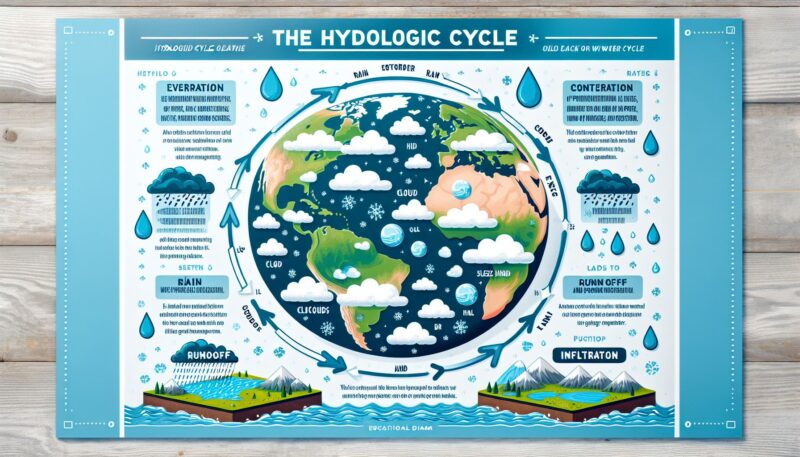Water is the lifeblood of our planet. It shapes the land, nourishes ecosystems, and sustains all forms of life. But have you ever pondered the journey water takes as it moves through Earth’s environment? That’s where the hydrologic cycle, also known as the water cycle, plays a pivotal role. This continuous system of water movement is critical for maintaining the balance of life on Earth, and understanding its processes is crucial for the preservation of our natural resources.
Understanding the Hydrologic Cycle
The hydrologic cycle describes the constant movement of water above, on, and below the Earth’s surface. It is a complex system driven by solar energy, and it involves several key processes: evaporation, transpiration, condensation, precipitation, infiltration, percolation, runoff, and groundwater flow.
The Sun: The Driving Force
The sun is the main energy source that fuels the water cycle. It heats water in oceans, rivers, and lakes, causing evaporation. This heat energy also aids in the transpiration process, where water is released from plants into the atmosphere.
Evaporation: Water’s Aerial Ascent
Evaporation occurs when water changes from a liquid to a gaseous state, rising into the atmosphere. This invisible vapor can travel long distances, rearranging the distribution of water across the globe.
Transpiration: Nature’s Contribution
Transpiration is a similar process to evaporation, but it involves water released from plants. This biological process contributes significantly to the amount of water vapor in the air.
Condensation: Formation of Clouds
When water vapor rises and cools in the atmosphere, it undergoes condensation, forming clouds. These clouds can drift across the sky, carrying water with them across various geographic locations.
Precipitation: Water’s Return
Precipitation occurs when the water droplets in clouds combine and grow heavy enough to fall to the ground due to gravity. Rain, snow, sleet, or hail returns water to the earth’s surface, replenishing lakes, rivers, and the soil.
Infiltration and Percolation: Beneath the Surface
Once water reaches the ground, it doesn’t stop moving. Some of it infiltrates the soil, moving below the surface through percolation. Infiltration happens when water soaks into the ground, while percolation is when it moves downward through soil and rock layers.
Runoff: The Path to Streams and Oceans
Not all water is absorbed by the ground; surface runoff occurs when water flows over the land. This process is critical for bringing water from the land to rivers, lakes, and ultimately to the oceans.
Groundwater Flow: The Hidden Reservoir
Ground water refers to the water that travels beneath the Earth’s surface, filling the porous spaces in soil, sediment, and rocks. Groundwater flow can be incredibly slow but contributes to baseflow in rivers and supports ecosystems during dry periods.
Baseflow: The Constant Stream
Baseflow is the sustained flow of a river that originates from groundwater seeping into the riverbed. During dry weather, baseflow maintains the flow of water in streams and rivers, supporting aquatic life and ecosystems.
The Importance of the Hydrologic Cycle
The water cycle is vital for several reasons:
-
Supports Life: Water is essential for the survival of all known forms of life. The hydrologic cycle ensures that water is renewed and available for use by living organisms.
-
Regulates Climate: Water vapor is a greenhouse gas that helps regulate the Earth’s temperature. The movement of water within the cycle also contributes to weather patterns.
-
Shapes the Earth: The processes within the cycle, such as runoff and precipitation, play a role in shaping the Earth’s surface through erosion and deposition.
-
Water Quality: By natural filtration through the ground, the cycle can improve the quality of water, though human activities can significantly impact this benefit.
Human Impact and Environmental Concerns
The hydrologic cycle is not immune to human influence. Here are some ways human activities can affect the cycle:
- Climate Change: Alterations in the earth’s climate can shift precipitation patterns, affecting water availability and exacerbating extreme weather events.
- Land Development: Urbanization can increase surface runoff and reduce infiltration, leading to flooding and decreased water quality.
- Water Withdrawal: Overuse of water for agricultural, industrial, and domestic purposes can deplete rivers and groundwater reserves, leading to water scarcity.
- Pollution: Contaminants from various sources can degrade water quality, affecting ecosystems and human health.
Protecting the Hydrologic Cycle
Understanding and respecting the hydrologic cycle is essential for the sustainable management of water resources. Here are some strategies to protect and preserve this vital system:
- Conservation Practices: Efficient water use and reducing waste can help maintain the balance of the cycle.
- Protection of Wetlands: Wetlands play a vital role in the hydrologic cycle by filtering pollutants and buffering against floods.
- Sustainable Development: Incorporating green infrastructure and permeable surfaces can help manage runoff and support infiltration.
- Pollution Prevention: Reducing the use of harmful chemicals and proper waste disposal can protect water quality.
Conclusion
The hydrologic cycle is a remarkable and intricate system that ensures the continuous movement and renewal of water on Earth. It supports life, shapes the environment, and sustains ecosystems. However, the cycle is vulnerable to human impact, and it is our responsibility to take steps to protect this vital resource. By understanding the role we play and taking action, we can ensure the health and longevity of the earth’s hydrologic cycle for generations to come.
Sources
-
“The Water Cycle” – U.S. Geological Survey (USGS)
https://www.usgs.gov/special-topic/water-science-school/science/water-cycle -
“Water in the Atmosphere” – National Oceanic and Atmospheric Administration (NOAA)
https://www.noaa.gov/education/resource-collections/freshwater/water-in-atmosphere
